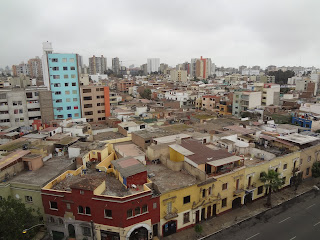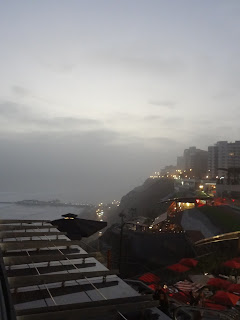Here's the part where I'm going to start raving about the tour group - G Adventures - we went with. Part of their ethos is to partner with local organizations wherever they work, and they have tours all over the world. Cuzco is a major hub for them, with tours coming and going to the jungle, several Andean hikes, Machu Picchu and other parts of Peru every single day. The hotel we stayed in at Cuzco appeared to be kept in business simply by their many tourists coming and going. Before we came into the Sacred Valley, we stopped at a village far off the beaten path - and I mean way up a twisting, one lane dirt road - where we were given a lesson in yarn making, dying and weaving by the local women, and then were able to purchase products from the women there. It was really great to get away from the main tourist traps of the region and to see the details of the handiwork they all do.
They ladies showed us how they traditionally spin the llama and alpaca wool, with a drop spindle that tugs down the wool by gravity and spins it tightly. A couple of people tried it out, and needless to say, it was very very hard to get good consistency of texture and thickness. The photo is of one of the eldest women in the village, who is charged with teaching all the younger girls how to spin.
After the wool is spun, it gets dyed. We were shown techniques for tradition color making, such as grinding red beetles from the jungle, then mixing them with salt, water or lime juice depending on what shade of red you want. On the stove was yarn being boiled with a kind of leaf to get green.
Then they do the actual weaving.
The village market was several small stalls surrounding a main square where the women were weaving and spinning. After our lesson in traditional yarn making and weaving, we shopped around.
In Inca times, what the citizens wore signified where they came from. Jacket color showed region (red for the Andes, black for the Lake Titicaca region and blue for Quito area, for example) and each village had their own hat style and color scheme. The Andes is really the only place where this tradition is still happening, but you can certainly see many women in traditional clothes everywhere you go.
Another fifteen minutes down the road, we came upon the first views of what is widely known as the Sacred Valley, a fertile valley with a strong glacial river that flows to the Amazon. Much of the agriculture that sustained Cuzco and the Inca empire came from this are. Following the river the in photo below takes you to the base of the mountain where Machu Picchu stands.
Our first stop in the Sacred Valley was Pisac, a village in the valley below the ruins of an Inca city and terraces. Some things I noticed all the Inca cities have in common: terraces, which help to cultivate crops on the steep mountain sides, and keep erosion from getting bad. These can also be found on random mountain sides, built for growing food. The cities were also always high in the air, not down in the valleys. It seems that it makes good sense to keep your cities far away from a point they can be ambushed, and those that ran the cities were in charge of keeping tabs on their citizens and who was traveling the Inca Trail - things that are easier done when you are above the people you are watching.
In the Inca class and societal system, every young male had to pay his taxes by doing manual labor 3 or 4 months a year, building cities on mountain tops or trails through the cloud forest. The cities like this were inhabited by nobles related to the emperor, with working class farmers and llama herders in the mountains all around. Pisac was over taken by the Spanish and mostly destroyed, with stones used in the valley below to build the current city, but what remains is picturesque.
Then we went to Ollantaytampo, the closest the Spanish ever got to Machu Picchu and the second to last place the Inca Emperor made a stand before finally being captured and killed. There are signs in the city that it was never quite complete, and that the Inca stopped work here perhaps because they needed to focus on their battles with the Spanish, perhaps because they saw their inevitable decline anyway. Near the Temple of the Sun, one can see still stonework that was being fashioned and prepared to move to wherever its final destination would be. Trains come through this town on their way to Machu Picchu, full of tourists, and the shops and hostels in the village were quaint, but bustling. Before the sun set, just as it started to get chilly again in the mountain air, we climbed into the explored the old city.
Rosa, our guide, called this our "training" day for the Trail. It was her 189th time hiking the Inca Trail with G Adventures and she had a very good idea of how many levels to go up the terraces before a rest, then a few more before another in order to help us all acclimate. I think at this point all of us were looking at each other wondering how in the hell we were going to make it up Dead Woman's Pass, the second day of the Trail where you hike straight uphill 1000 meters, or about 3 or 4 hours, if we couldn't even climb some stairs without feeling our hearts jumping from our chests. (Spoiler alert: we all made it up the mountain two days later.)
Inca stone work is an incredible thing, especially when you consider how far they had to get these stones up the mountain, then put them into place, not to mention how many earth quakes they have survived. These walls were just below the Temple of the Sun, where the stonework gets more advanced because of the passing of years and gaining of knowledge, as well as intricacy given to a holy place.
This is the actual not completed altar of the Temple of the Sun, where you can still see the perforations in the stones which were used to move them (wheels were not used on the steep mountain sides) and which faces the sunrise on the Summer Solstice.
More explorations in the city.
Down in the modern part of the village, the streets run with ancient aqueducts and drainage systems to bring fresh glacial water through the village safely into the river beyond.
We spent the night in a hotel together, took final showers that night and ate a big meal, toasting to our last electricity, hot water and bed before we started the Inca Trail, which we would begin early the next morning.



















































